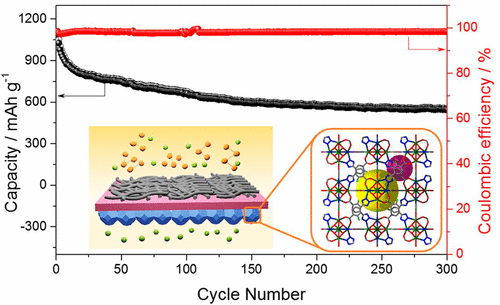当前位置:
X-MOL 学术
›
ACS Energy Lett.
›
论文详情
Our official English website, www.x-mol.net, welcomes your
feedback! (Note: you will need to create a separate account there.)
Metal–Organic Framework-Based Separators for Enhancing Li–S Battery Stability: Mechanism of Mitigating Polysulfide Diffusion
ACS Energy Letters ( IF 19.3 ) Pub Date : 2017-09-15 00:00:00 , DOI: 10.1021/acsenergylett.7b00692 Mengliu Li 1 , Yi Wan 1 , Jing-Kai Huang 1 , Ayalew H. Assen 1 , Chia-En Hsiung 2 , Hao Jiang 2 , Yu Han 2 , Mohamed Eddaoudi 2 , Zhiping Lai 2 , Jun Ming 1 , Lain-Jong Li 1
ACS Energy Letters ( IF 19.3 ) Pub Date : 2017-09-15 00:00:00 , DOI: 10.1021/acsenergylett.7b00692 Mengliu Li 1 , Yi Wan 1 , Jing-Kai Huang 1 , Ayalew H. Assen 1 , Chia-En Hsiung 2 , Hao Jiang 2 , Yu Han 2 , Mohamed Eddaoudi 2 , Zhiping Lai 2 , Jun Ming 1 , Lain-Jong Li 1
Affiliation

|
The shuttling effect of polysulfides severely hinders the cycle performance and commercialization of Li–S batteries, and significant efforts have been devoted to searching for feasible solutions to mitigate the effect in the past two decades. Recently, metal–organic frameworks (MOFs) with rich porosity, nanometer cavity sizes, and high surface areas have been claimed to be effective in suppressing polysulfide migration. However, the formation of large-scale and grain boundary-free MOFs is still very challenging, where a large number of grain boundaries of MOF particles may also allow the diffusion of polysulfides. Hence, it is still controversial whether the pores in MOFs or the grain boundaries play the critical role. In this study, we perform a comparative study for several commonly used MOFs, and our experimental results and analysis prove that a layer of MOFs on a separator did enhance the capacity stability. Our results suggest that the chemical stability and the aggregation (packing) morphology of MOF particles play more important roles than the internal cavity size in MOFs.
中文翻译:

基于金属-有机骨架的隔膜,用于增强Li-S电池的稳定性:减轻多硫化物扩散的机制
多硫化物的穿梭效应严重阻碍了锂-硫电池的循环性能和商业化,并且在过去的二十年中,人们一直在努力寻找可行的解决方案以减轻这种影响。最近,据称具有丰富孔隙率,纳米腔尺寸和高表面积的金属有机骨架(MOF)可有效抑制多硫化物迁移。然而,形成大规模且无晶界的MOF仍然是非常具有挑战性的,其中MOF颗粒的大量晶界也可能允许多硫化物的扩散。因此,MOF中的孔或晶界起关键作用仍然是有争议的。在这项研究中,我们对几种常用的MOF进行了比较研究,我们的实验结果和分析证明,隔板上的MOF层确实提高了容量稳定性。我们的结果表明,MOF颗粒的化学稳定性和聚集(堆积)形态比MOF的内部空腔尺寸更重要。
更新日期:2017-09-15
中文翻译:

基于金属-有机骨架的隔膜,用于增强Li-S电池的稳定性:减轻多硫化物扩散的机制
多硫化物的穿梭效应严重阻碍了锂-硫电池的循环性能和商业化,并且在过去的二十年中,人们一直在努力寻找可行的解决方案以减轻这种影响。最近,据称具有丰富孔隙率,纳米腔尺寸和高表面积的金属有机骨架(MOF)可有效抑制多硫化物迁移。然而,形成大规模且无晶界的MOF仍然是非常具有挑战性的,其中MOF颗粒的大量晶界也可能允许多硫化物的扩散。因此,MOF中的孔或晶界起关键作用仍然是有争议的。在这项研究中,我们对几种常用的MOF进行了比较研究,我们的实验结果和分析证明,隔板上的MOF层确实提高了容量稳定性。我们的结果表明,MOF颗粒的化学稳定性和聚集(堆积)形态比MOF的内部空腔尺寸更重要。









































 京公网安备 11010802027423号
京公网安备 11010802027423号